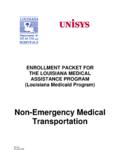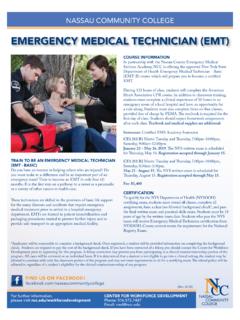Transcription of Common EMS Treatment Guidelines
1 2007 (2007-01) Update Common EMS Treatment Guidelines Developed by the County Wide Protocol Committee Lee County Florida 2007 (2007-01) Update 2007 (2007-01) Update PARTICIPATING AGENCIES Agency Level of Service Provided Alva Fire and Rescue BLS / non transport Bayshore Fire Protection and Rescue Service District BLS / non transport Boca Grande Fire Control District BLS / non transport Bonita Springs Fire Control and Rescue District ALS / non transport Captiva Fire Control District BLS / non transport Cape Coral Fire.
2 Rescue and Emergency Management Services ALS / non transport City of Fort Myers Fire Department ALS / non transport Estero Fire and Rescue District ALS / non transport Fort Myers Shores Fire and Rescue Control District BLS / non transport Iona McGregor Fire District ALS / non transport Lee County EMS ALS / transport Lee County Airport Rescue and Fire Fighting BLS / non transport Lehigh Acres Fire Control District ALS / transport Matlacha Pine Island Fire Control District BLS / non transport North Fort Myers Fire Control and Rescue District BLS / non transport San Carlos Park Fire Protection and Rescue District ALS / non transport Sanibel Fire and Rescue District ALS / non transport South Trail Fire Protection and Rescue District ALS / non transport Tice Fire and Rescue District BLS / non transport Upper Captiva Fire and Rescue District BLS / non transport Useppa Island Fire Department BLS / non transport 2007 (2007-01) Update TABLE OF CONTENTS SECTION I.
3 GENERAL MEDICAL Guidelines 1 INTENT AND USE OF Guidelines 2 INTRODUCTION TO ADULT INITIAL ASSESSMENT AND MANAGEMENT 3 ADULT INITIAL ASSESSMENT 4 PEDIATRIC INITIAL ASSESSMENT 6 AIRWAY MANAGEMENT 8 AIRWAY OBSTRUCTION 10 CONSCIOUS SEDATION 11 MEDICAL SUPPORTIVE CARE 12 TRAUMA SUPPORTIVE CARE 13 PAIN MANAGEMENT 14 PATIENT RESTRAINT 15 REFUSAL OF CARE 16 ADVANCED DIRECTIVE PREEXISTING CONDITIONS. 18 DEATH IN FIELD SIGNAL 7 19 AIR transport 23 MASS CASUALTY START TRIAGE 26 MASS CASUALTY JUMPSTART TRIAGE 28 transport DESTINATION GUIDELINE 30 FIREFIGHTER REHABILITATION GUIDELINE 31 SECTION II: CARDIAC ARREST 1 CARDIAC ARREST INITIAL APPROACH 2 VENTRICULAR FIBRILLATION OR PULSELESS WIDE COMPLEX TACHYCARDIA 4 ASYSTOLE 5 PULSELESS ELECTRICAL ACTIVITY 6 TRAUMATIC CARDIAC ARREST 7 SECTION III: CARDIAC EMERGENCIES 1 ACUTE CORONARY SYNDROME 2 ACUTE PULMONARY EDEMA, HYPOTENSION AND SHOCK 3 WIDE COMPLEX TACHYCARDIA 4 SYMPTOMATIC ATRIAL FIBRILLATION/ATRIAL FLUTTERS 5 PREMATURE VENTRICULAR CONTRACTION (PVCS) 6 SYMPTOMATIC BRADYCARDIA 7 SUPRA VENTRICULAR TACHYCARDIA (SVT) 8 SECTION IV.
4 ENVIRONMENTAL EMERGENCIES 1 NEAR DROWNING 2 HEAT RELATED ILLNESS 3 MARINE LIFE ENCOUNTERS 4 POISONOUS SNAKE BITE AND ENVENOMATION 5 ANAPHYLACTIC REACTIONS 6 SECTION V: MEDICAL EMERGENCIES 1 CHRONIC OBSTRUCTIVE PULMONARY DISEASE (COPD)\REACTIVE AIRWAY DISEASE /ASTHMA 2 CROUP / EPIGLOTTITIS 3 HYPERVENTILATION SYNDROME 4 ACUTE ABDOMEN 5 DIABETIC EMERGENCIES 6 HYPOVOLEMIC SHOCK 7 2007 (2007-01) Update OVERDOSE/POISONING 8 COMA/UNCONSCIOUSNESS 9 SEIZURES 10 STROKE / 12 NAUSEA AND VOMITING 13 SECTION VI.
5 OB / GYN 1 NORMAL DELIVERY 2 SPONTANEOUS ABORTION 3 ECLAMPSIA 4 SUPINE HYPOTENSION SYNDROME 5 BREECH / LIMB PRESENTATION 6 PROLAPSED UMBILICAL CORD 7 NEONATAL RESUSCITATION 8 SECTION VII: TRAUMA 1 HEAD INJURIES 2 ORTHOPEDIC EMERGENCIES 3 SOFT TISSUE INJURIES 4 BURNS 5 APPENDIX A : PHARMACOLOGY REFERENCE 1 ADENOCARD (ADENOSINE) 2 ASPIRIN 3 ATROPINE (ATROPINE SULFATE) 4 BENADRYL (DIPHENHYDRAMINE HYDROCHLORIDE) 5 CARDIZEM 6 CORDARONE (AMIODARONE) 7 D5W (5% DEXTROSE IN WATER) 9 DEXTROSE (D25W/D50W) 10 DIPRIVAN (PROPOFOL) 11 DOPAMINE (INTROPIN) 12 DUONEB 13 EPINEPHRINE 14 ETOMIDATE (AMIDATE) 15 GLUCAGON 16 LACTATED RINGERS 17 LASIX (FUROSEMIDE) 18 LIDOCAINE (XYLOCAINE) 19 LOPRESSOR (METOPROLOL) 20 MAGNESIUM SULFATE 21 MORPHINE 23 NARCAN (NALOXONE) 25 NITROGLYCERIN DRIP (TRIDAL) 26 NITROGLYCERIN SPRAY 28 NORMAL SALINE ( SODIUM CHLORIDE) 30 OXYGEN 31 PHENERGAN (PROMETHAZINE) 32 PROVENTIL (ALBUTEROL SULFATE) 33 SODIUM BICARBONATE 34 SOLUMEDROL (METHYLPREDNISOLONE) 35 SUCCINYLCHOLINE (ANECTINE / QUELICIN)
6 36 THIAMINE (VITAMIN B1) 37 VALIUM (DIAZEPAM) 38 VASOPRESSIN 39 VERSED: (MIDAZOLAM) 40 2007 (2007-01) Update APPENDIX B: BLS MEDICAL PROCEDURES / CHECKLISTS 1 AMBU LARYNGEAL MASK 2 BAG-VALVE-MASK VENTILATION 3 BLOW-BY OXYGEN 4 COMBITUBE 5 ENDOTRACHEAL INTUBATION PREPARATION 6 EPINEPHRINE AUTO-INJECTOR 7 HELMET REMOVAL 8 HIP IMMOBILIZATION 9 INHALER ADMINISTRATION 10 IV THERAPY SET UP 11 KENDRICK EXTRICATION DEVICE (KED) 12 LONG BACKBOARD IMMOBILIZATION 14 NASAL CANNULA 15 NASOPHARYNGEAL AIRWAY PLACEMENT 16 NON-REBREATHER MASK 17 OROPHARYNGEAL AIRWAY PLACEMENT 18 RAPID EXTRICATION (BTLS METHOD) 19 RAPID EXTRICATION (KED METHOD) 20 RAPID EXTRICATION (SHORT BACKBOARD METHOD) 21 AUTOMATIC EXTERNAL DEFIBRILLATION 22 SLING & SWATHE 23 SPINAL IMMOBILIZATION (SEATED) 24 SPINAL IMMOBILIZATION (STANDING) 25 SPINAL IMMOBILIZATION (SUPINE/PRONE)
7 27 SPLINTING 29 SUCTIONING 30 TRACTION SPLINT 31 VITAL SIGNS 32 APPENDIX C: ALS MEDICAL PROCEDURES / CHECKLISTS 1 BLOOD ALCOHOL SAMPLING 2 CARDIAC MONITORING 3 CHEST ESCHAROTOMY 4 CONTINUOUS POSITIVE AIRWAY PRESSURE (CPAP) 6 CRASH AIRWAY MANAGEMENT PROCEDURE 8 CRICOTHYROTOMY (SURGICAL) 11 CRICOTHYROTOMY (NEEDLE) 12 END TIDAL CO2 DETECTORS 13 ENDOTRACHEAL INTUBATION 14 ENDOTRACHEAL MEDICATIONS 15 1 STERNAL 16 GLUCOMETER 17 IN-LINE INTUBATION 18 INTERNAL JUGULAR VEIN CANNULATION 19 INTRAMUSCULAR INJECTION 20 INTRAOSSEOUS CANNULATION 21 IV ACCESS - PERIPHERAL 22 IV DRUG PREPARATION / ADMINISTRATION 23 MANUAL DEFIBRILLATION 24 MEDICATION ADMINISTRATION PORT (MAP) 25 NASOGASTRIC TUBE PLACEMENT 26 NASOTRACHEAL INTUBATION 27 NEBULIZER THERAPYINDICATIONS.
8 28 NEEDLE CHEST DECOMPRESSION (ANTERIOR APPROACH) 30 NEEDLE CHEST DECOMPRESSION (MID-AXILLARY APPROACH) 31 2007 (2007-01) Update PERICARDIOCENTESIS 32 PULSE OXIMETERY 33 RECTAL VALIUM ADMINISTRATION 34 SUBCLAVIAN VEIN CANNULATION 35 SUBCUTANEOUS MEDICATION ADMINISTRATION 36 SYNCHRONIZED CARDIOVERSION 37 TRANSCUTANEOUS PACING 38 TUBE CHECK DEVICES 39 UMBILICAL VEIN CANNULATION 40 VAGAL NERVE STIMULATION 41 VENOUS CATHETERS 42 12 LEAD ECG 43 APPENDIX D: FORMS 1 TRAUMA transport PROTOCOL LEE COUNTY EMS 1 REFERENCES 1 SECTION I: GENERAL MEDICAL Guidelines 2007 (2007-01) Update SECTION I-1 Section I: General Medical Guidelines SECTION I: GENERAL MEDICAL Guidelines 2007 (2007-01) Update SECTION I-2 INTENT AND USE OF Guidelines These medical Treatment Guidelines have been developed as a part of the medical direction program for Emergency Medical Services (EMS) in Lee County, Florida.
9 The Treatment Guidelines have been designed as clinical guides, not as educational documents. Some patients may require therapy not specified herein. The Treatment Guidelines should not be construed as prohibiting such flexibility. The First Responder, EMT, or Paramedic must use his/her judgment in administering Treatment in the following manner: The First Responder, EMT, or Paramedic may determine that no specific Treatment is needed; or The First Responder, EMT, or Paramedic may consult medical direction before initiating any specific Treatment ; or The First Responder, EMT, or Paramedic may follow the appropriate Treatment Guideline and then consult medical direction. The Guidelines outline care for a typical case. As the Guideline continues, the assumption is usually made that previous steps were ineffective.
10 For example, when treating a patient in ventricular fibrillation, the V-Fib Guidelines would be followed. If the patient s rhythm changed to PEA, then the PEA Guidelines would be followed. In this or other situations where a change is made to a different Guideline during the course of care, the paramedic's judgment must determine where entry into the new Guideline sequence is appropriate. It would be impractical to write Guidelines that specify every possible sequence of events. The order of Treatment listed may not be appropriate for all situations. In fact, not all Treatment options may be indicated in every situation. The paramedic's judgment must be relied upon to determine which of the authorized Treatment procedures are appropriate for a given situation.




